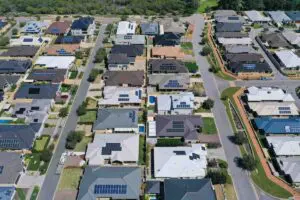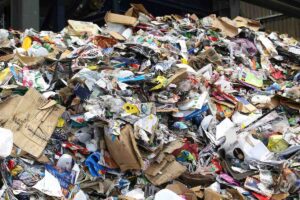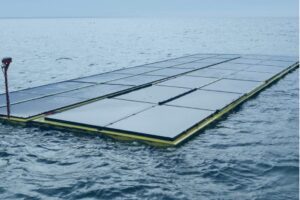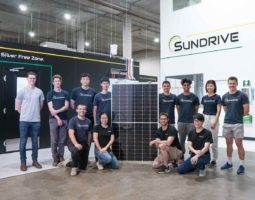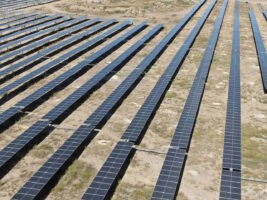Australia could be a global leader in climate mitigation and zero-carbon energy exports, and meet its domestic power demands “on the side,” according to a new energy transition scenario that would take us well beyond 100 per cent renewables, to a target of 200 per cent.
The reasoning is relatively simple. By producing far more electricity than it needs – from mostly solar but also wind – Australia can become an exporting superpower of clean energy. And having excess capacity means fewer gaps in its domestic supply, and less need for back-up facilities and so lower costs.
The “Leadership + Export” scenario is one of six modelled as part of series of “Synthesis reports” published by the Australian-German Energy Transition Hub – a bilateral and federal government-backed initiative for research on energy transition opportunities.
The Australia’s power advantage: Energy transition and hydrogen export scenarios report, presented at a symposium hosted by the University of Melbourne on Wednesday, maps out scenarios running from Status Quo, to NDC (Paris targets), Accelerated, Accelerated + Export, Leadership, and Leadership + Export.
But it is the final scenario – also called the “200% Renewable Scenario” – that catches the eye, for its modelling of a renewable energy roll-out that goes “far beyond” current electricity demand, driving down costs of technologies and taking power prices along for the ride.
According to that scenario, domestic demand (represented by the dotted white line in Figure 7) is “met almost on the side” by oversized capacity of mainly solar PV.
 As the report explains it, for each week of the year, “average electricity supply significantly exceeds average demand,” with that surplus generation available for use through the electrolytic production of hydrogen for domestic storage and for export.
As the report explains it, for each week of the year, “average electricity supply significantly exceeds average demand,” with that surplus generation available for use through the electrolytic production of hydrogen for domestic storage and for export.
In this scenario, electrolysers would roughly follow the patterns of solar PV, operating with high flexibility in day-night cycles in line with a summer-peaking seasonal pattern.
This would require large-scale hydrogen storage to decouple hydrogen production from transport and export, the report says.
Under this scenario, additional grid balancing and flexibility requirements would also be reduced, thus reducing system-related costs with, and average electricity prices, which “converge towards the pure generation costs (LCOE) of renewable electricity,” which you can see illustrated in figures 5 and 6.

 Short-term storage and transmission, however, remain part of the optimised system, and are used to distribute generation – both from A to B and at different times – and also to smooth electricity input to electrolysers, to increase their capacity factor and bring down the costs of producing hydrogen.
Short-term storage and transmission, however, remain part of the optimised system, and are used to distribute generation – both from A to B and at different times – and also to smooth electricity input to electrolysers, to increase their capacity factor and bring down the costs of producing hydrogen.
“There is a significant co-benefit of generating hydrogen in a renewable-based system. Building up a hydrogen export economy is therefore an additional driver for deploying renewables for domestic demand,” the report concludes.
The Energy Transition Hub’s range of scenarios mark just the latest to be put forward for consideration by policy makers and industry regulators – including the range of pathways flagged by the Australian Energy Market Operator just last month.
As Giles Parkinson reported, AEMO confirmed that it would model a “Step Change” shift to renewables that will include rapid adjustments in technology costs and a “well below 2°C” Paris climate scenario as part of its 20-year planning blueprint known as the Integrated System Plan.
Like the AEMO modelling, and other modelling before it, the Energy Transition Hub report makes a couple of other key points worth noting again.
The first is that even under the “status quo” scenario, with no additional energy or climate policy, wind and solar PV would still dominate new generation development – because they are cheaper than anything else – “and no new coal power plant is built (Figure 4).”
And finally, it reminds us – as does the DNV GL report here – that effective and stable government policy remains all important.
“Policy has an important role to play. A cost-effective, timely energy transition that unlocks the potential for new industries, supports affected regions, and protects ecosystems is not guaranteed – it is an outcome achievable in both Germany and Australia with effective policy,” the report says.
It notes that proven policy approaches include mechanisms to reduce risks for investors and ensure low-cost financing, as well as incentive-based policies to internalise the societal benefits of zero-emissions energy.
“Regulatory and energy market reforms will be needed to ensure efficient investment in new electricity generation and other energy production, infrastructure for transmission and storage of energy, additional demand flexibility to help with a cost-effective integration of variable renewables,” the report says.
“Getting regulatory settings right will help achieve lower energy costs and electricity prices. Governments are also needed to help manage the transition in regions where fossil- based industries are prominent.
“Finally, governments have an important role to play in determining the opportunities for large-scale renewables-based export industries, including using hydrogen as an energy carrier. They may also have important roles in paving the way for such industries by establishing suitable regulatory and fiscal frameworks, facilitating infrastructure development where applicable, and helping to coordinate cross-country investment and trade in new energy.”
This leaves Australia with much work to do, particularly in light of Wednesday’s news that Australia has been barred from speaking at next week’s UN climate change summit, due to its continued support for coal.




